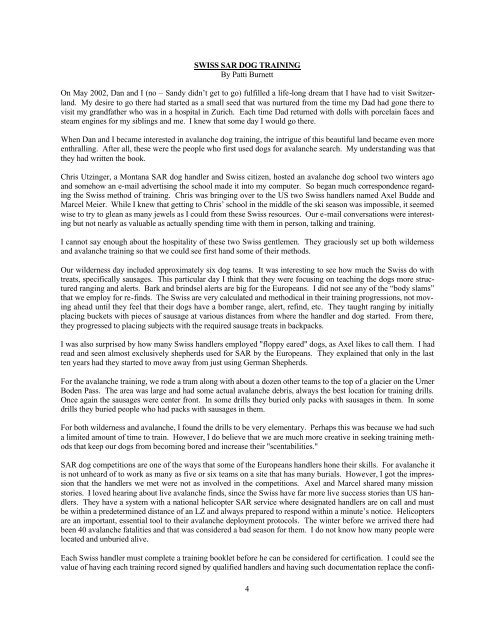February, 2004 Scent Articles - Search and Rescue Dogs of Colorado
February, 2004 Scent Articles - Search and Rescue Dogs of Colorado
February, 2004 Scent Articles - Search and Rescue Dogs of Colorado
You also want an ePaper? Increase the reach of your titles
YUMPU automatically turns print PDFs into web optimized ePapers that Google loves.
SWISS SAR DOG TRAINING<br />
By Patti Burnett<br />
On May 2002, Dan <strong>and</strong> I (no – S<strong>and</strong>y didn’t get to go) fulfilled a life-long dream that I have had to visit Switzerl<strong>and</strong>.<br />
My desire to go there had started as a small seed that was nurtured from the time my Dad had gone there to<br />
visit my gr<strong>and</strong>father who was in a hospital in Zurich. Each time Dad returned with dolls with porcelain faces <strong>and</strong><br />
steam engines for my siblings <strong>and</strong> me. I knew that some day I would go there.<br />
When Dan <strong>and</strong> I became interested in avalanche dog training, the intrigue <strong>of</strong> this beautiful l<strong>and</strong> became even more<br />
enthralling. After all, these were the people who first used dogs for avalanche search. My underst<strong>and</strong>ing was that<br />
they had written the book.<br />
Chris Utzinger, a Montana SAR dog h<strong>and</strong>ler <strong>and</strong> Swiss citizen, hosted an avalanche dog school two winters ago<br />
<strong>and</strong> somehow an e-mail advertising the school made it into my computer. So began much correspondence regarding<br />
the Swiss method <strong>of</strong> training. Chris was bringing over to the US two Swiss h<strong>and</strong>lers named Axel Budde <strong>and</strong><br />
Marcel Meier. While I knew that getting to Chris’ school in the middle <strong>of</strong> the ski season was impossible, it seemed<br />
wise to try to glean as many jewels as I could from these Swiss resources. Our e-mail conversations were interesting<br />
but not nearly as valuable as actually spending time with them in person, talking <strong>and</strong> training.<br />
I cannot say enough about the hospitality <strong>of</strong> these two Swiss gentlemen. They graciously set up both wilderness<br />
<strong>and</strong> avalanche training so that we could see first h<strong>and</strong> some <strong>of</strong> their methods.<br />
Our wilderness day included approximately six dog teams. It was interesting to see how much the Swiss do with<br />
treats, specifically sausages. This particular day I think that they were focusing on teaching the dogs more structured<br />
ranging <strong>and</strong> alerts. Bark <strong>and</strong> brindsel alerts are big for the Europeans. I did not see any <strong>of</strong> the “body slams”<br />
that we employ for re-finds. The Swiss are very calculated <strong>and</strong> methodical in their training progressions, not moving<br />
ahead until they feel that their dogs have a bomber range, alert, refind, etc. They taught ranging by initially<br />
placing buckets with pieces <strong>of</strong> sausage at various distances from where the h<strong>and</strong>ler <strong>and</strong> dog started. From there,<br />
they progressed to placing subjects with the required sausage treats in backpacks.<br />
I was also surprised by how many Swiss h<strong>and</strong>lers employed "floppy eared" dogs, as Axel likes to call them. I had<br />
read <strong>and</strong> seen almost exclusively shepherds used for SAR by the Europeans. They explained that only in the last<br />
ten years had they started to move away from just using German Shepherds.<br />
For the avalanche training, we rode a tram along with about a dozen other teams to the top <strong>of</strong> a glacier on the Urner<br />
Boden Pass. The area was large <strong>and</strong> had some actual avalanche debris, always the best location for training drills.<br />
Once again the sausages were center front. In some drills they buried only packs with sausages in them. In some<br />
drills they buried people who had packs with sausages in them.<br />
For both wilderness <strong>and</strong> avalanche, I found the drills to be very elementary. Perhaps this was because we had such<br />
a limited amount <strong>of</strong> time to train. However, I do believe that we are much more creative in seeking training methods<br />
that keep our dogs from becoming bored <strong>and</strong> increase their "scentabilities."<br />
SAR dog competitions are one <strong>of</strong> the ways that some <strong>of</strong> the Europeans h<strong>and</strong>lers hone their skills. For avalanche it<br />
is not unheard <strong>of</strong> to work as many as five or six teams on a site that has many burials. However, I got the impression<br />
that the h<strong>and</strong>lers we met were not as involved in the competitions. Axel <strong>and</strong> Marcel shared many mission<br />
stories. I loved hearing about live avalanche finds, since the Swiss have far more live success stories than US h<strong>and</strong>lers.<br />
They have a system with a national helicopter SAR service where designated h<strong>and</strong>lers are on call <strong>and</strong> must<br />
be within a predetermined distance <strong>of</strong> an LZ <strong>and</strong> always prepared to respond within a minute’s notice. Helicopters<br />
are an important, essential tool to their avalanche deployment protocols. The winter before we arrived there had<br />
been 40 avalanche fatalities <strong>and</strong> that was considered a bad season for them. I do not know how many people were<br />
located <strong>and</strong> unburied alive.<br />
Each Swiss h<strong>and</strong>ler must complete a training booklet before he can be considered for certification. I could see the<br />
value <strong>of</strong> having each training record signed by qualified h<strong>and</strong>lers <strong>and</strong> having such documentation replace the confi-<br />
4


